Spinner bait are highly popular and bring extra excitement for all anglers, regardless of their expertise. So, if you haven’t tried spinners by now, it is high time you do it!
The first step is to learn how to tie a spinner bait properly. I’ll make it easy for you! All you need to do is keep scrolling, follow the simple steps I’ve provided, and you’ll tie your first spinner fishing lure in no time at all!
Once you master the basics, you can put the information into action and share the excitement of spinner bait fishing. Spinners are versatile and fun; you can use them almost anywhere for any fish species.
For instance, bass fishing enthusiasts always have a selection of spinner baits in their tackle box. Yet, it does not matter whether you’re after a 10-pound bass, 40-pound catfish, or a small panfish – spinnerbait will help you reach your goals and have a memorable fishing day.
So, let’s get down to business and learn how to tie spinner fishing lures!
How To Tie A Spinner Bait To Your Fishing Line: Step-by-Step Instructions
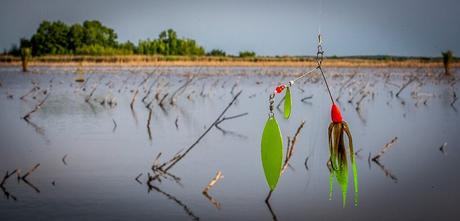
You’ll only need a few minutes to read my instructions and tips on tying up a spinner bait. Make time. You’ll get your reward once you start casting spinning bait and catching more fish.
Get Familiar With All Spinner Bait Components
It is always a good idea to try and learn as much as you can about anything you are planning to do – before you actually do it. Tying fishing bait is no different. Hence, you ought to familiarize yourself with all the parts of the spinner bait before you get to the point of tying it to your fishing line.
Here are the components that make up every spinner lure:
The Blade
The spinner bait blade is a piece of shiny metal that makes this type of lure a success on the water. Its primary purpose is to increase the visibility of the lure by reflecting light.
How does it work?
It’s simple. When a spinning bait gets into the water, the blade shines and glistens to attract the fish. Therefore, it is the main component that makes spinners triumph in murky, dirty water. Some blades even produce a rattling noise to attract more attention in clouded waters, just like chatter bait.
There are four different types of spinner blades to choose from:
- Willow Blades
This type of blade is pointed at both ends. It typically consists of two blades attached to a wire. A willow blade does not produce a lot of movement in the water, nor does it vibrate much. It attracts fish only by reflecting light.
There are also so-called willow-leaf blades that are a bit more narrow and rigid than the regular willow blades. Their design enables them to cut through the water more efficiently. They sink faster, too.
- Colorado Blades
An oval-shaped Colorado blade features a swivel that enables it to spin around in the water. In this way, it not only shines but also creates plenty of movement for fish to notice and bite your bait.
- Indiana Blades
An Indiana blade is a blend of willow and Colorado blade. It is shaped like an oval but has a point on one end.
The Wire
The spinnerbait wireframe is a crucial component that holds everything together and helps the lure cut through the water more efficiently. One end of the wire holds a blade, while the other end connects to a jig head.
The Eye
A spinnerbait eye serves to connect the lure to a fishing line. The eyes are typically shaped as a letter R, rather than loops. Modern spinning bait sometimes feature complete circles to ensure a more secure connection with the line.
The Jig
A jig represents the head of the lure. It attaches to the wireframe and provides weight and balance.
Spinnerbait are not designed for diving deep into the water. Hence, the purpose of the jig is to enable the lure to sink just slightly beneath the water surface and come back up as you retrieve it.
The Hook
Most spinnerbait hooks are regular straight hooks with a barb at their end. Some spinnerbait feature a skirted jig that covers the hook and prevents it from getting tangled into the weeds.
Extra Advice: If you want to spice up your spinner and make it more attractive for fish, try adding a bit of power bait onto the hook. The scent will get you more attention and thus more fish, too. It works wonders when bass fishing!
Locate The Spinnerbait Eye And Pull Your Line Through It
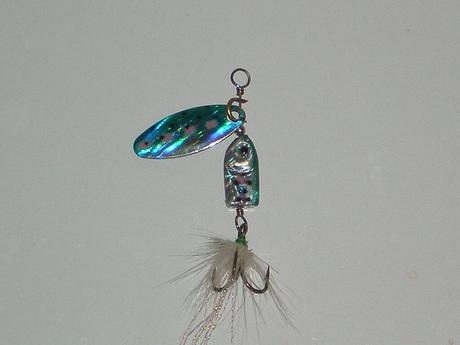
Now that you have mastered the anatomy of the spinnerbait, it is time to put it to good use. First, you need to locate the eye on your spinner and pull enough fishing line through it to tie a knot. Typically, 6 to 12 inches of fishing line should suffice.
Choose & Tie The Best Knot To Secure The Line
Not just any loop knot will do for spinners. You must learn the proper knots for a secure line tie.
There are a few possible knots for you to choose from depending on the type of fishing line you are using and the size of your spinner bait. Here are the best combos:
- If you opt for a monofilament line, tie it in a Clinch knot.
- If you use a fluoro or braided line with a small spinnerbait, tie a Palomar knot or a Trilene knot.
- If you use a fluoro or braided line with a large spinnerbait, tie a San Diego Jam knot.
Of course, nothing is written in the stone. If you have a knot you trust and prefer, stick to it. If not, try the ones I have suggested and decide which one works the best for you.
Keep scrolling to learn how to tie these popular fishing knots.
Clinch/Cinch Knot
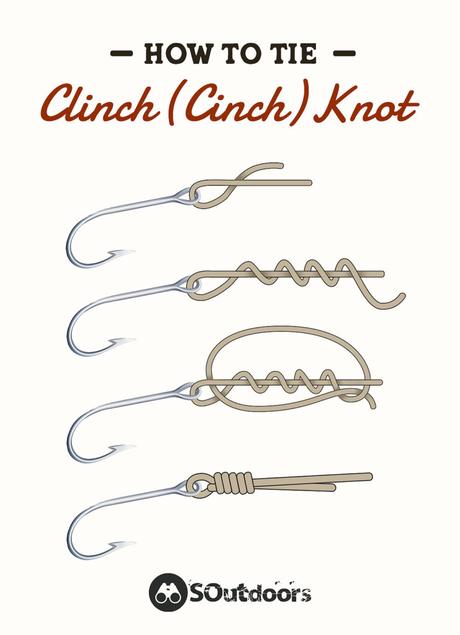
The clinch (or cinch) knot is the most popular type of knot for attaching spinnerbait and is quite simple to master, too. Here’s how you tie it:
- Start by passing the tag end of the line through the eye and forming a loose loop. Make sure you have enough tag line to wrap around the main line (at least 7-8 inches).
- Start wrapping the tag line away from the lure. Do it 5 or 6 times. Try to keep your wraps uniform.
- Once you are done wrapping the line, pass the tag end back down through the bottom loop you have created (just above the hook eye).
- Wet the standing line, hold everything in place, and then pull the tag end of the line down smoothly to draw the knot tight.
- Cut the excess line.
If you are still having a hard time, check out the video below:
Palomar Knot
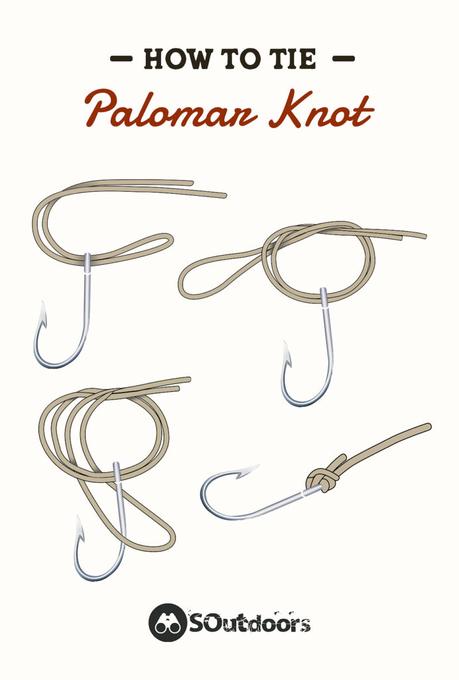
The Palomar knot is highly versatile and can be used to tie a number of lures, spinners included. It is similar to an overhand knot but stronger and thus an ideal choice for targeting big fish and bass fishing.
Let’s learn how to tie it!
- Create a so-called “double line” by doubling the end of the line to create a loop. Pass the loop through the lure’s eye.
- Bring the loop back around and pass it through the remaining line. You should form a complete circle.
- Tie an overhand knot around your standing line, but as you tighten it, make sure you leave a loop that is large enough for you to pass the entire spinnerbait through.
- Pull the spinner through the loop. Pull the standing line into a secure knot. I recommend wetting the knot to reduce friction and the risk of splintering the line.
Watch the following video for a helpful Palomar knot lesson:
Trilene Knot
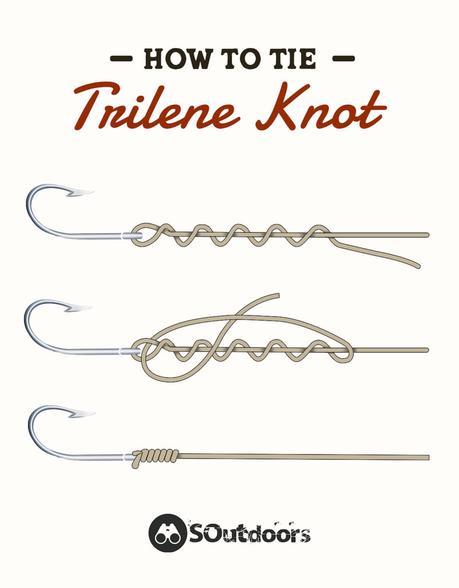
The Trilene knot is an improved clinch knot used for the line tie in deep sea fishing from boats. It is one of the strongest knots suitable for targeting big fish. Here’s how to tie it:
- Hold the spinner in your non-dominant hand and pass the line through the eye twice. Leave a loose loop the second time around.
- Twirl the standing line around the main line about 5-6 times
- Pass the end of the line through the small loop you have created.
- Hold the end of the line in place with your left hand and pull it tight. It would be best to moisten it first.
- Trim the excess line.
Extra Advice:
Try to look for the spinner bait that already have an eye formed from the wire. It will eliminate the need to make your own eye for the line tie.
If you find any of these steps confusing, check out the video:
San Diego Jam Knot
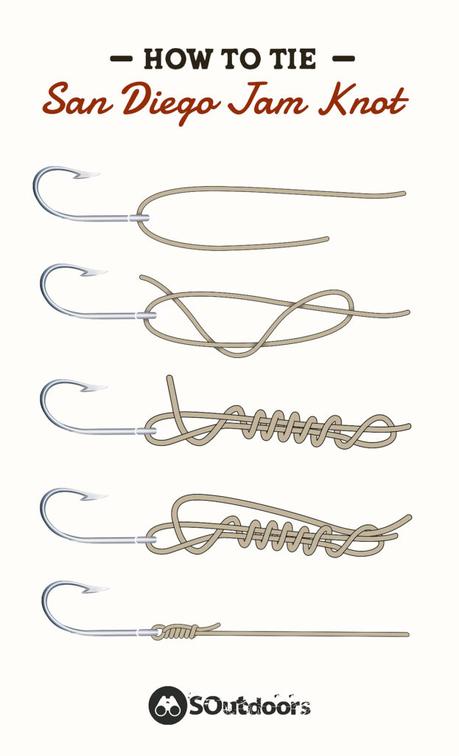
The San Diego Jam knot, or the Reverse clinch knot, has been popularized by San Diego tuna anglers. It is suitable for all types of lines, quick to tie, and highly reliable. Here is how to craft a San Diego knot:
- Start by passing the end of the line through the eye of your spinner. Let the lure hang down.
- Use the line to form a loop over your index finger.
- Pinch the loop and wrap the line around the double line all the way down to the eye (7-10 wraps).
- Take the tag end through the bottom loop below the last wrap, and then bring it back through the loop you have made at the beginning. Run it through the second loop and remove your index finger.
- Moisten the line and slowly pull down the tag end to slide the knot tight.
If you want to see an improved version of the San Diego Jam knot, watch the video that follows:
Extra Advice: Even though a secure knot is more important than the type of fishing line, it does not mean you should not pay any attention to the latter. Most spinnerbait go perfectly well with 14 to 17-lb test in either monofilament or fluorocarbon. The braid should be used with spinner bait when fishing around heavy vegetation.
FAQs
What is the best knot for a spinnerbait?
The best knot for a spinnerbait is the one that best serves your needs. If you are a newbie, start with a clinch knot. Palomar is the best option for bass fishing, while Trilane and San Diego knots are indispensable for saltwater fishing adventures.
Do you use a bobber with spinner bait?
You can use a bobber with spinner bait when you want to present your lure at an exact depth. I use the bobber when I know fish are stacked up at a certain depth.
Do you use weights with spinners?
You can use weights with spinners if you want to maintain them higher up in the water column. I recommend weights such as 1/4oz and 3/8oz to keep your spinnerbait safe above the underwater weed.
Can you use a swivel with a spinnerbait?
You can use the swivel with a spinnerbait if you want, but you do not have to. The spinnerbait already has plenty of action and natural movement in the water since the line is tied directly to its wire frame.
Time To Test Your Skills
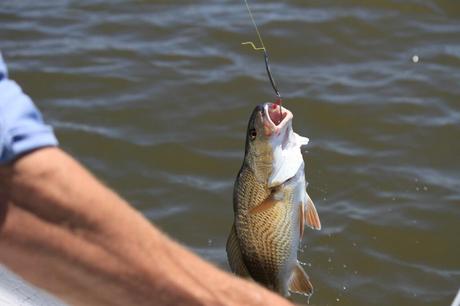
Reading is not nearly as exciting as fishing. So, what are you waiting for? Go to your favorite fishing hole and put all the information you have just read into action. The sooner, the better!
Now that you know how to tie a spinner, you can target a variety of species, such as walleye, crappie, or largemouth bass. The flash and vibration these lures produce will help you catch fish and provide more fun along the way!
Just make sure you perfect your knot-tying skills to secure your spinnerbait adequately and avoid break-offs. Good luck!
If you have any questions or helpful fishing tips about tying a spinnerbait, please share them with the rest of us! Leave a comment below, and I’ll get back to you.

